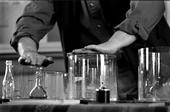a short blurb:
Miguel Frasconi uses glass objects, electronics, keyboards, and "de-evolved" instruments to create music that sounds from a uniquely imagined tradition. His glass instruments have been called "a beautiful menagerie of pealing contraptions" (Time Out NY), while his music has been called "lyrical and stormy" (New York Times). His recent activities include a new score for choreographer Alonzo King, performances with electronic music pioneer Morton Subotnick, a newly commissioned work for Gamelan Son of Lion, and concerts with the composers collective Ne(x)tworks. He is currently artist in residence at Harvestworks electronic media studios.
Purchase my cd SONG + DISTANCE here:
Amazon.com or
New Albion Records or
download from iTunes
a personal history:
First and foremost I am a composer who performs. My first serious instrument was the piano, then flute, then piano again (then electronics, then glass, then sampler, then glass again). When I was in my early teens (the early '70s) I became fascinated with pure sound, experimental music, and the then very young minimalist movement. I graduated high school early in order to study electronic music privately at a local college. I was living an hour outside of NYC and would go hear tons of new music concerts, both "uptown" and "downtown." During my college years (York University, Toronto, 1975-79), I was fortunate enough to work with John Cage, David Tudor, Cornelius Cardew, Pauline Oliveros, Frederick Rzewski, Petr Kotik, Harold Budd, Derek Bailey, Jon Hassell, as well as ongoing studies with James Tenney (composition & ensemble performance), David Rosenboom & Richard Teitelbaum (electronic music), Casey Sokol (piano & improvisation), Bob Becker (percussion), and Jon B. Higgins & Trichy Sankaran (Carnatic music). I continued visiting Cage about twice a year for the next ten years or so, and went on to tour with Jon Hassell and play on 5 of his albums.
During my high school fascination with pure sound, I was introduced to the sonic potential of glass and put together my first glass instrument using all of my parent's stemware. In 1977, at the York U. electronic music studios, I noticed that some of my friends were also using glass as a sound source in their tape pieces. I thought: why don't we all get together and try to make this same kind of "electronic" music without any electricity, using only glass (and candles for lighting). After getting kicked out of many a Toronto house-ware store for making too much noise, The Glass Orchestra was born. I was able to use all of my eclectic studies to create what was essentially a self-contained new "world music culture."
After University, I continued living in Toronto in order to stay with the Glass Orchestra. During this time, I played flute and piano in many improvisation ensembles, co-directed a new music repertoire ensemble (the New Music Co-op), was a founding member of the Evergreen Club Gamelan Ensemble, and continued making electronic music. (During the early '80s, John Oswald & I were exchanging tape pieces that eventually evolved into what he later called "plunderphonics.") After a brief career as a new music "concert pianist," my piano playing evolved to playing synthesizer, then sampler, and now laptop (will technology please STOP). I left The Glass Orchestra in it's 9th year, in 1986, lived in NY and played with Gamelan Son of Lion for a year. I then moved to the San Francisco Bay Area where I ended up playing synth and sampler with the Paul Dresher Ensemble for many years, playing in the post-industrial urban folk music sound sculpture band Mobius Operandi, and composing much music for dance.
Sampler playing (and programming) became my "thing" during the '90s, with the SF Bay Guardian calling me "the Bay Area sampler guru." I basically thought of it as a self-contained, keyboard activated hyper-Glass Orchestra. But technology doesn't stop. So here in the 21st century, while I have been reading software manuals and loading up my laptop with all the hottest music software, I have returned to glass (although I never really left) where I can use tried and true techniques to continue discovering new and familiar sounds, just as I did 20-odd years ago.
Basically I am a classically trained musician who, instead of devoting himself to one specific instrument, has devoted himself to the exploration of SOUND, new and familiar and ALIVE, through the use of electronics, glass objects, computer technology, and some good old keyboard virtuosity (when called for).
